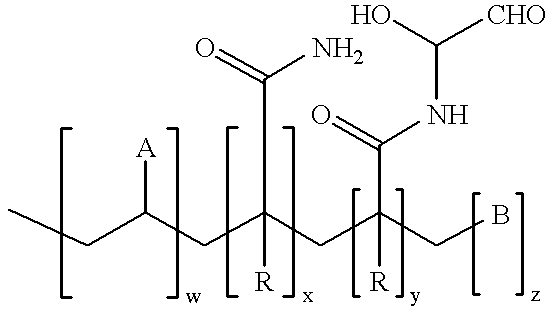Soft, bulky single-ply absorbent paper having a serpentine configuration
a single-ply absorbent paper, soft technology, applied in the direction of patterned paper, non-fibrous pulp addition, transportation and packaging, etc., can solve the problems of low thickness, inability to determine cationic starches, lack of perceived softness that is inimical to consumer acceptance, etc., to facilitate the absorbent paper, low dry strength, suitable temporary wet strength
- Summary
- Abstract
- Description
- Claims
- Application Information
AI Technical Summary
Benefits of technology
Problems solved by technology
Method used
Image
Examples
example 2
A one-ply homogeneously-formed tissue sheet was formed from a furnish containing 40% softwood kraft fibers which had a coarseness of 29.1 mg / 100 m and a weight-weighted fiber length of 3.13 mm, and 30% hardwood kraft fibers having a coarseness of 9.7 mg / 100 m and a weight-weighted fiber length of 0.93 mm. The remainder of the tissue was composed of southern hardwood kraft fibers. The overall furnish had a weight average coarseness to length ratio of 8.08 mg / 100 m / mm. A wet strength starch and an imidazoline-based debonder were added to the furnish in the amounts of 12 lbs / T and 0.5 lbs / T respectively. Two and one-half pounds / ton of a spray softener were applied to the sheet while it was on the felt. A second one-ply homogeneously-formed tissue sheet was formed from a furnish containing 35% softwood kraft fibers which had a coarseness of 29.1 mg / 100 m and a weight-weighted fiber length of 3.13 mm, and 65% hardwood kraft fibers having a coarseness of 8.3 mg / 100 m and a weight-weighted...
example 3
This example illustrates that a lower weight average coarseness to length ratio corresponds to a higher sensory softness for a variety of fiber blends and fiber types.
Eight one-ply homogeneously-formed tissue prototypes were produced from a variety of furnish blends. The constituent pulps that were used in creating the various fiber blends and their properties are shown in Table 4 below.
TABLE 4 Fiber Fiber Fiber Coarseness Length-Weight Designation Fiber Type (mg / 100 meters) Weighted (mm) A Softwood Kraft 29.1 3.13 B Softwood Kraft 19.1 2.79 C Hardwood Kraft 8.3 0.93 D Hardwood Kraft 9.7 0.93 E Hardwood Kraft 12.8 1.35 F Secondary Fiber 14.8 1.78
Each of the fiber blends was treated with a wet-strength enhancing starch and an imidazoline-based debonder. The add-on levels of the starch and debonder were varied to produce base sheets having approximately the same wet and dry tensile strengths. The sheets were also sprayed with 2.5 lbs / ton of a softener, which was applied to the sheet w...
example 4
Two of the products from Example 3, product #1 and product #4 were selected for closer examination. As can be seen from FIG. 1, these two products are made from furnish blends that have a similar weight average coarseness to length ratio even though the hardwood and softwood percentages of the two products are quite different. Product #1 contains primarily hardwood along with some high-coarseness softwood, while product #4 is made chiefly from low-coarseness softwood fibers, along with some hardwood. As is shown in Table 6, the physical properties of the two embossed tissue products are also similar, except that the formation of product #1 is higher than that of product #4. This higher formation is probably a consequence of product #1's higher hardwood content, as formation and hardwood content tend to be positively correlated.
TABLE 6 Basis Weight Caliper MD CD MD CD CD Wet Tensile Product lbs / mils / Tensile Tensile Stretch Stretch Tensile Stiffness Friction # ream 8 sheet gr / 3" gr / ...
PUM
| Property | Measurement | Unit |
|---|---|---|
| weight average coarseness | aaaaa | aaaaa |
| temperature | aaaaa | aaaaa |
| temperature | aaaaa | aaaaa |
Abstract
Description
Claims
Application Information
 Login to View More
Login to View More - R&D
- Intellectual Property
- Life Sciences
- Materials
- Tech Scout
- Unparalleled Data Quality
- Higher Quality Content
- 60% Fewer Hallucinations
Browse by: Latest US Patents, China's latest patents, Technical Efficacy Thesaurus, Application Domain, Technology Topic, Popular Technical Reports.
© 2025 PatSnap. All rights reserved.Legal|Privacy policy|Modern Slavery Act Transparency Statement|Sitemap|About US| Contact US: help@patsnap.com



